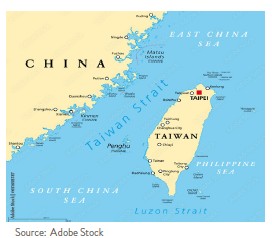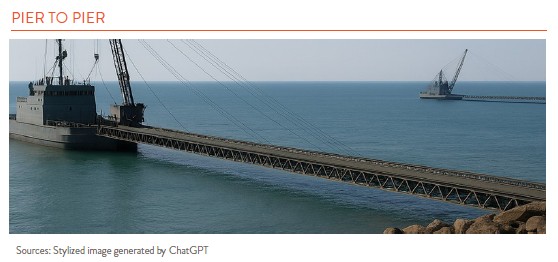We are all watching the fighting in Ukraine and the Middle East in real time today. Both are certainly serious but neither involve a direct confrontation between the world’s biggest powers, China and the U.S. The Taiwan issue, however, does. We would not be surprised if this resurfaces as a major flashpoint sometime during the remaining three years of the Trump administration.

Since Xi Jinping took power in 2012, he has made reunification with Taiwan a central feature of his “China Dream” revival plan. Xi has reportedly instructed the military to be prepared to attack the island by 2027. Recent U.S. administrations have acknowledged China’s claim over Taiwan but without endorsing that claim (our “One China policy”).
The Biden administration said it “does not support” Taiwan independence but claimed if Taiwan were attacked, we would defend it, although exactly how and to what extent was left unsaid. The Trump administration has been basically silent as to what it would do if China attacked the self-governed island democracy.
A direct attack on Taiwan by China might take a number of forms. China’s Navy has performed numerous war drills around the island, and its Air Force has continuously probed Taiwan’s defenses and entered Taiwan’s air space. Earlier this year it was reported that China has built numerous barge-borne bridges (see picture below) which can offload non-amphibious vehicles and troops onto Taiwan’s rocky coastline. In addition, China has developed hypersonic missiles which could effectively keep U.S. aircraft carriers well away from the Taiwan war theater.

There are other options short of a direct attack on the island. These “gray zone” tactics might include either a full blockade of the island or a quarantine where the Chinese Coast Guard performs searches of ships, ostensibly to enforce customs regulations, halt the spread of disease, or to prevent weapons from reaching the island.
Andy Kessler, writing in The Wall Street Journal thinks the West has the tools necessary to stop a military invasion of Taiwan. The U.S. would “Putinize” China, cutting it off from financial markets. The West could also blockade China, stopping the shipment of oil and foodstuffs which the mainland relies on. A big question, however, is would the rest of the world work effectively with the U.S. to isolate China, especially after our President has acted as a “rent-seeking landlord” with respect to tariff policies aimed at friend and foe alike? Taiwan is not Ukraine, and it might not elicit the same level of global support.
China is currently using a strategy which could forestall the need for a full-scale invasion—breaking the back of Taiwan’s confidence and its will to resist. The Lowy Institute, an Australian think tank, estimates that by the end of this year, 119 countries, 62% of the UN’s member states, will have endorsed China’s sovereignty over Taiwan, including “all” efforts to achieve unification.
Taiwan’s dysfunctional governing system is not helping to project a united front against China. The DPP, which favors independence, controls the presidency but the mainland-appeasing KMT party controls the legislature. This has led to policy gridlock.
Taiwan has a valuable trump card in TSMC which manufactures 90% of the world’s most sophisticated semiconductor chips. The West does not want it to fall into China’s hands. But skeptics question whether Taiwan’s younger generation, which has grown up in economic affluence, actually has the will to fight. As some have said, Taiwan’s youth are like “strawberries,” beautiful on the outside, soft on the inside.
The Taiwan question could ultimately come down to Donald Trump. When Chairman Xi meets with Trump, possibly later this year, some expect he will propose a mega offer; you agree to our position on Taiwan, and we will give you the trade victory you have been chasing since the election. This could be the straw that breaks the camel’s back. Polls show that 80% of Taiwanese today want to keep independence from China, but only 20% think this is feasible long term.